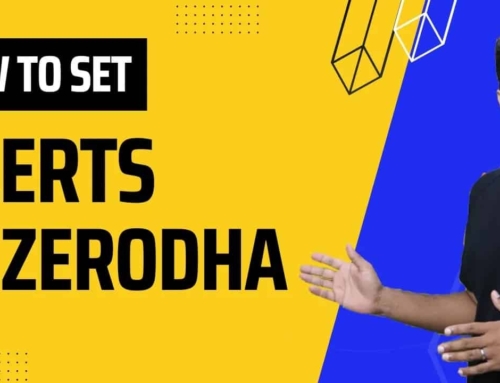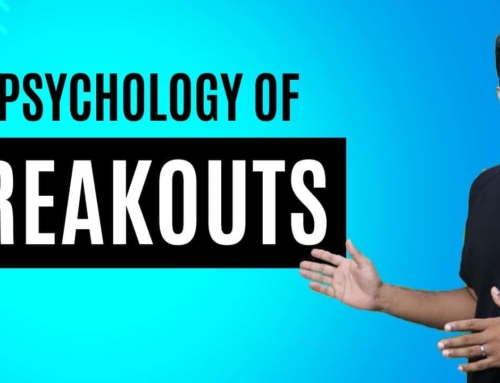The Ultimate Stock Market Crash Course
For many of us, Stock markets, though widely viewed as a treasure trove where large sums of money can be made, can be a very confusing place.
It is often considered tricky with its innumerable jargon, complex maze of rules and regulations, absence of verifiable information, and lack of proper education on the subject.
We do not generally know enough about money until the age when we start earning. This is because the means to achieve financial independence and financial planning are not subjects that are taught to us during our school days and are also not a topic of discussion with our parents in our households.
So what are the chances of someone trying to enter the stock market and make money with a high level of confidence? Probably zero because the fear of losing money in stocks is overwhelming not just to us as individuals but also to our family as a whole. That explains why stock market participation in our country is at an abysmal rate of 5% when compared to other developed economies.
When we start earning our first salary, we are often told that the only investment avenues that are supposed to be safe and reliable are Real estate, Insurance, and Gold. Agents and brokers of financial instruments often cash in on this sentiment by selling us products that are neither useful to us in the present nor the future. The result is that we invest in products that provide us sub-optimal returns and also put the lives of our loved ones at risk in our absence.
The first thought when we wanted to create a course for beginners who wished to enter the Stock Market is that they should be armed with enough knowledge to take on the mighty bulls of the investment world. We then went ahead and created 3 types of courses starting with a course for someone who is a novice in the markets to someone who already has the knowledge but wants to learn the advanced concepts.
Who is this crash course then for?
This is for someone who doesn’t know the basics of finance and investing but wants to enter the world of stocks and make a decent amount of money.
We have created this course in simple language without the usage of technical jargon and terminology. Anyone with basic common sense can understand the concepts and apply them in real-time trading.
So we will do this crash course in three parts. This is going to be part one where we will start with the absolute basics and parts two and three where we will cover the Intermediate and Advanced concepts of the stock market. At the end of each of these videos, we will have quizzes and will have very short, simple, but interesting assignments so that you can understand whatever you learned. The objective is to analyze if you have understood those concepts and whether you can apply those concepts in real life. It’s going to be very interesting and engaging with tons of real-life examples.
Hence am excited to share all this knowledge with you guys. So without any further ado, let’s get going.
I am sure that we all know about matchmaking websites, such as shaadi.com and jeevansathi.com. Today I will show you a place where millions of matches are made every day and here, it doesn’t take several weeks or months for a match to happen. The matchmaking here happens within a fraction of a second. So in case, you’re wondering, no, I’m not talking about another matrimonial website but the Stock exchanges which are globally the biggest wealth creators.
They are the biggest matchmakers in the whole world. Except of course they’re not matching brides and grooms. They are matching buyers with Sellers. So if you want to buy shares of a company, they will find the perfect Seller for you.
On the other hand, if you want to sell your shares, they will also find the perfect buyer for you and you don’t even have to go anywhere else. You have the option of placing an order for Buy or Sell through the phone or place it through your computer and the Stock Exchange will do the rest.
Every country has at least one big Stock Exchange. India has two major Stock Exchanges, National Stock Exchange (NSE) and the Bombay Stock Exchange (BSE). BSE is the oldest among the two dating back to 1875. Now, apart from these two, there are other smaller regional Stock Exchanges, but for all practical intents and purposes, you don’t have to worry about them. You just need to know about NSE and BSE. Now between these two exchanges should you buy your shares from the BSE or the NSE?
This is a question that a lot of beginners ask. Well, think of it this way. Let’s say you want to buy a Samsung phone and it’s available on both Amazon and Flipkart at the same price and the same terms and conditions. So will it matter whether you buy it from Amazon or whether you buy it from Flipkart? It shouldn’t, isn’t it? This is because you get the same product at the same price on both these exchanges.
Similarly, most of the well-known companies are listed on both exchanges. Reliance, for example, is listed on both the BSE and the NSE. If I plan to buy shares of Reliance, I can go and buy them either from the NSE or the BSE. It doesn’t matter. If you’re an investor, buy it from either of these exchanges as it doesn’t make any difference. However, if you are a trader, there are some key differences between these two exchanges which I have explained in a separate video. You might also want to check it out.
Coming back to the business of buying shares. How do we buy shares from NSE or BSE? Do we have to physically go to the Stock Exchange or can we go to the website of the respective Stock Exchanges and place orders there? Do these Stock Exchanges have some kind of an app like Bigbasket, Grofers, etc where we place orders for groceries, foodstuff, etc?
We cannot directly buy and sell shares from the Stock Exchanges as they can’t deal directly with millions of individual customers. Hence they authorize certain brokers through which orders can be placed.
A broker is a middleman between the investor and the Stock Exchange. To buy and sell shares of a company, we log into the broker’s terminal and place the order. The broker in turn sends that order to the Stock Exchange.
In India, we have hundreds of brokers, with UpStox, AngelBroking, ShareKhan, ICICI direct, Zerodha, etc. being the most prominent of them. The first step before starting to trade is to open an account with one of these brokers. This can be done by going to any broker’s website, submit a few documents online, and you can now open an account within a few minutes. Now, this broking account that you open with the broker is also called the Trading Account.
Let’s now take a real-life example to understand all these terms that we have talked about so far.
- Let’s say I want to buy 1000 shares of Reliance. Hence the first thing that I will do is to log into my broker’s account. Now the broker, in this case, is Zerodha. Now for buying 1000 shares of Reliance, I need to have some money in my account. So the first thing that I need to do is to transfer money from my bank account to this Trading account. Now at the time of opening up the Trading account with Zerodha, I had given them the details of my account held with Axis Bank. So my Axis bank account and Zerodha’s Trading account are now both linked.
- What this means is that I can transfer money from my Axis bank to Zerodha and I can take the money out of my Zerodha account and transfer it back to my Axis bank account. So in my case here, if I have to buy 1000 shares of Reliance, I need to have at least 20 lakh rupees in my account. If I don’t have enough funds in my Trading account, what I can do is I can log in to the Zerodha Trading account, click on add funds, and then I can transfer the amount that I need to buy these shares from my bank account.
- Simultaneously, I log into my bank account, give the credentials, and transfer the funds that I need to buy these shares. The best part here is that the transfer of funds happens immediately. Similarly, if I have some excess cash in my Trading account, what I can do is I can transfer the money out of this Trading account back to my bank account. For this transfer, I will use the withdraw button. So this is how we can keep transferring funds between the bank accounts and the Trading account. Now I have the money in my Trading account to buy 1000 shares of Reliance and am all set. The next step is to place an order which is shown in the next paragraph.
- On the left-hand side, this is the place where I can search for the stocks that I want to buy and sell. In this case, since we want to buy Reliance shares, I will search for Reliance now. When I search for Reliance you get several other entries that can be ignored. I will talk about these in the later sessions. Right at the top, I see two options wherein I can buy the shares of Reliance from the NSE or the BSE. Now, let me add both of these to see if there is any difference in price between BSE and NSE. It’s just like buying a phone where if I were to buy the phone, I would like to buy it from the place where it’s selling for cheap. However, in this case, you can see that the price of Reliance on both the BSE and the NSE is almost the same. This is what happens for all the major companies where the prices are almost the same on both exchanges. Once in a while, there might be a difference of 5 paise or 10 paise which is very negligible.
What it means is that I can buy it from anywhere and it doesn’t matter. So let me pick NSE now.
- Just take a look at this order entry screen here. I’m instructing my broker as to the number of shares and the price that I want to purchase. So once I’m done with specifying my instructions, I can place this order. Now, as soon as I place this order, this is what happens behind the scenes. My broker, Zerodha takes that order, sends it to the Stock Exchange, and then NSE, in turn, matches me to a Seller who’s willing to sell 1000 shares of Reliance at the price that I had specified. The moment NSE finds a Seller, who is willing to sell his shares as per my criteria, matches me with that Seller. As soon as the matching is over, the order gets complete. An amount of approximately Rs. 20 lakh rupees excluding the transaction charges will be debited from my Trading account and it will be credited to the Seller’s Trading account.
- 1000 shares of Reliance will then be taken from the Seller’s account and it will be transferred to me instantly. Once the transfer of shares has happened, these shares will now show up in the holdings tab of my Trading account. Here I can see the details of all the shares that I hold. So during the market hours, this is basically what happens every single hour, every single minute, and every single second. People place their order to the brokers, the brokers then send the orders to the Stock Exchange and the Stock Exchanges, in turn, matches those orders.
There are billions of transactions that happen during the day in Stock Exchanges throughout the world. An important aspect that needs to be considered is that we neither interact with the Stock Exchange nor with the Buyer/Seller on the other side. As an investor, we deal only with the broker. Hence it becomes very important for us to pick a broker whom we can trust and several factors go in the selection of a broker. So if you guys want us to make a video on how to select the right broker for you, what criteria to consider, let us know in the comments below and we will be happy to make a video on that topic.
So going back to the previous example, I wanted to buy 1000 shares of Reliance. I’m happy that I bought them and am hoping to make money from my investment. Hold on, hold on. What is this share? I bought these 1000 shares of Reliance. What exactly did I buy? Well, a share is exactly what it sounds like. A share in the company means ownership of the company. So when I bought shares of Reliance, I became a shareholder of the company, a part-owner of the company. So in my case, I’m a proud owner of Reliance, just like Mukesh Ambani.
However, that doesn’t imply that I can walk into any Reliance office or I can walk into Mr.Mukesh Ambani’s office and ask them for money. Though I am a shareholder, I’m only a part-owner. I cannot exercise my right as an owner to reach out and ask for money. So some of you might be now wondering as to what is the point of buying the shares of Reliance? What is the point of calling yourself a shareholder or a part-owner if you cannot get money from Reliance or Mr. Mukesh Ambani? Well, a shareholder makes money in two ways. Please pay attention to the below as it is very important.
Two ways to make money:
- A shareholder makes money if the share price of the company goes up. So in my case, if the share price of Reliance goes from Rs.2000 to let’s say Rs.3000 or Rs.4,000 or Rs.10,000. I can then sell these shares at a higher price and make a profit. So that is the most common way a shareholder makes money.
- The second way a shareholder makes money is through Dividends, which are the profits that the companies occasionally distribute among its investors. So Reliance, for example, can say that we made so much money this year and we would like to distribute some of these profits among our shareholders. In that case, they will distribute these profits to the shareholder, including myself, and I will make some money through dividends as well. Now on dividends specifically, we have made an awesome video. Do check it out to understand exactly how dividends work.
So those were the two benefits of being a shareholder, but not every shareholder is like you and me. There are three types of shareholders,
- Promoters: Promoters are usually the people who started the company or are currently running the company. In the case of Reliance, the promoters are, of course, the Ambani family as they hold about 50% of shares in Reliance
- Big Institutions: Then we have the big institutions such as Mutual funds, Hedge funds, Sovereign Wealth Funds, and sometimes even the government. So this class of investors is buying the shares of Reliance on behalf of their investors. Now, these institutions can further be classified into domestic and foreign depending on their country of origin. In the case of Reliance, the domestic institutions, own about 15% of shares, and the foreign institutions, hold about 25%. So in total, the institutional holding in Reliance is about 40%.
- Retail Investors: And last, but not least come retail investors like you and me who have bought the shares of Reliance in the expectation that the stock prices will go up, or maybe we will get some dividends. On purchase of these 1000 shares, I have joined this esteemed group of investors who account for about 10% of shares in Reliance.
Now that we know the different types of shareholders, let’s just go back to the shares that we bought. So I bought these shares of Reliance. How exactly will I get my shares? Will I get some kind of a document or a share certificate sent out to my home? How do I keep track of the shares that I have purchased? Well, there was a time when people used to get physical certificates of shares. 30 years ago, my dad bought shares of a company called Binani Cement and we got the physical share certificate delivered at home and they looked awesome and I got super excited looking at them. But those were the olden days of paper certificates. Now we live in a digital world and everything has become electronic. These days, shares are bought and sold only in electronic format and there are enormous benefits of having shares stored in the digital format.
Benefits of Shares in digital format:
- There is no risk of losing it and damaging it. So it will never get stolen.
- There is no risk of forgery or faking of the share certificates.
- The transfer of shares from one account to the other has become extremely easy. So let’s say you want to transfer shares from your account to your daughter’s account. You can easily do that online.
One question that occurs in my mind is where exactly are these shares stored? Are they stored in their Trading account with the broker or are they stored in my bank account? In my case, I bought these 1000 shares of Reliance, and hence are they going to be stored in my Zerodha’s Trading account or my Axis bank account? This is something a lot of people don’t understand. Please understand very carefully because this is very important. The shares are neither stored with the broker nor are they stored in any bank account?
Hence, in my case, the shares are neither going to be stored with Zerodha nor are they going to reflect in my Axis bank account. The reason why shares are not stored with any broker is that would be very dangerous. What if the broker shuts down their business tomorrow? If Zerodha goes out of business tomorrow, my shares would also be gone with them. If it happens, how do I chase them to get my shares back? That’s going to be a big hassle.
It is for this reason that the brokers are not allowed to keep any shares with them and neither are the shares stored in the bank account. Where exactly are the shares stored then? The shares are stored in a completely different, safe account called a Demat account.
Demat is an acronym for dematerialized and this is the place where the shares are actually stored.
In a tab called Holdings, you showed me all the shares that you bought in the Zerodha account. Now, why are you telling me that they are not stored in the Zerodha account? That is true. It’s a very good observation. Though you can see the shares that you bought in your Zerodha Trading account, these shares are stored in the Demat account. So think of the Demat account as a bank account for your shares and that’s where they are stored. In India, there are only two companies as of now that are authorized to open Demat accounts, CDSL and NSDL and every broker has to tie up with one of these companies. Zerodha, for example, has tied up with CDSL. When I open a Trading Account with Zerodha they also open a Demat account with CDSL.
Whenever I buy any shares through Zerodha, they will eventually be stored in my CDSL Demat account. Hence Zerodha’s Trading account and the CDSL’s Demat account are linked.
Let me show you guys the procedure real quick.
This is my Trading account with Zerodha right? You have already seen this now. If you can observe, this is my Demat account with CDSL. To log in to this account, I have to, first go to CDSL’s website and log in. The account credentials here are completely different from the one on my Zerodha account. I create a user ID and password that are completely different. Once I log in, I can see all the shares that I have bought through Zerodha. This is the account where the shares are stored. Now some of you might be thinking that I have a Trading Account with a broker and also have this Demat account.
How do they all work together? For that, let’s take a look at the big picture. Please note that this is very important and hence pay attention. I first opened a Trading Account with Zerodha and at the time of opening this account, I also connected my bank account with this Trading account.
When Zerodha’s Trading account was opened, they also opened a Demat account for me through CDSL and this is where my shares will be stored. When I placed the Buy order from Zerodha for those 1000 shares of Reliance, Zerodha sent that order to the Stock Exchange, NSE in my case, and then, NSE matched me to a Seller. After completion of this transaction, the money from my Trading account was deducted and transferred to the Seller’s account and those 1000 shares of Reliance were deducted from the Seller’s account and were transferred to my Demat account. This is the big picture.
Please take a moment to understand how this overall picture looks like. Now, the point to note about a Demat account is that you don’t have to log in to your Demat account to do anything from a day-to-day perspective because a Demat account and the Trading account are linked.
All the shares that are available in their Demat account are also visible in my Trading account. I only have to log into my Trading account for the purchase and sale of shares. So guys, if you have made it so far, then congratulate yourself because you have learned a lot, really a lot, and trust me, now, you know more about the Stock market than an average person. However, we are not done yet. A couple of things that I want you to do.
- I want you to take a short quiz so that you can test your understanding of the Stock market. You can test your understanding of how much you have grasped from this video using this short quiz.
- Secondly, this is a very distinct assignment. Do you know what is the best way of learning something new? The best way of learning something new is to teach it. So the Nobel prize-winning physicist Richard Feynman introduced his technique called The Feynman Technique in which he said that if you want to learn something new, just teach it.
This is what I want you to do. Pick someone from your family or your friends. It can be your son, daughter, husband, wife, your parents, or your friends, and explain to them the concepts that you have learned in this video in as simple terms as possible.
If you can explain to them what you have learned, congratulations because now you have educated that person and other loved ones. However, if you struggle to explain these concepts to them, it means you are not very clear and which is perfectly fine. So go back to this video, watch it again, clarify those concepts, and if you still have any questions for which you require clarity, mention those in the comments below. We will be more than happy to answer your questions. So those are the two things that I want you to do.
Finally, that’s it for this video. I hope you guys learned something new and you now understand it in the most practical way possible. Trust me; it takes a lot of time and effort on our part to make these kinds of videos. So if you’re learning something from it, please give us feedback by liking these kinds of videos, sharing them so that we get the right encouragement to make more informative videos.
Howdy!
If you’re here for the first time, let’s get introduced.
VRD Nation is India’s premier stock market training institute and we (Team VRD Nation) are passionate about teaching each and every aspect of investing and trading.
If you’re here for the first time, don’t forget to check out “Free Training” section where we have tons of free videos and articles to kick start your stock market journey.
Also, we got two awesome YouTube channels where you can continue the learning process.
Must-Read Articles
The Ultimate Stock Market Crash Course
For many of us, Stock markets, though widely viewed as a treasure trove where large sums of money can be made, can be a very confusing place.
It is often considered tricky with its innumerable jargon, complex maze of rules and regulations, absence of verifiable information, and lack of proper education on the subject.
We do not generally know enough about money until the age when we start earning. This is because the means to achieve financial independence and financial planning are not subjects that are taught to us during our school days and are also not a topic of discussion with our parents in our households.
So what are the chances of someone trying to enter the stock market and make money with a high level of confidence? Probably zero because the fear of losing money in stocks is overwhelming not just to us as individuals but also to our family as a whole. That explains why stock market participation in our country is at an abysmal rate of 5% when compared to other developed economies.
When we start earning our first salary, we are often told that the only investment avenues that are supposed to be safe and reliable are Real estate, Insurance, and Gold. Agents and brokers of financial instruments often cash in on this sentiment by selling us products that are neither useful to us in the present nor the future. The result is that we invest in products that provide us sub-optimal returns and also put the lives of our loved ones at risk in our absence.
The first thought when we wanted to create a course for beginners who wished to enter the Stock Market is that they should be armed with enough knowledge to take on the mighty bulls of the investment world. We then went ahead and created 3 types of courses starting with a course for someone who is a novice in the markets to someone who already has the knowledge but wants to learn the advanced concepts.
Who is this crash course then for?
This is for someone who doesn’t know the basics of finance and investing but wants to enter the world of stocks and make a decent amount of money.
We have created this course in simple language without the usage of technical jargon and terminology. Anyone with basic common sense can understand the concepts and apply them in real-time trading.
So we will do this crash course in three parts. This is going to be part one where we will start with the absolute basics and parts two and three where we will cover the Intermediate and Advanced concepts of the stock market. At the end of each of these videos, we will have quizzes and will have very short, simple, but interesting assignments so that you can understand whatever you learned. The objective is to analyze if you have understood those concepts and whether you can apply those concepts in real life. It’s going to be very interesting and engaging with tons of real-life examples.
Hence am excited to share all this knowledge with you guys. So without any further ado, let’s get going.
I am sure that we all know about matchmaking websites, such as shaadi.com and jeevansathi.com. Today I will show you a place where millions of matches are made every day and here, it doesn’t take several weeks or months for a match to happen. The matchmaking here happens within a fraction of a second. So in case, you’re wondering, no, I’m not talking about another matrimonial website but the Stock exchanges which are globally the biggest wealth creators.
They are the biggest matchmakers in the whole world. Except of course they’re not matching brides and grooms. They are matching buyers with Sellers. So if you want to buy shares of a company, they will find the perfect Seller for you.
On the other hand, if you want to sell your shares, they will also find the perfect buyer for you and you don’t even have to go anywhere else. You have the option of placing an order for Buy or Sell through the phone or place it through your computer and the Stock Exchange will do the rest.
Every country has at least one big Stock Exchange. India has two major Stock Exchanges, National Stock Exchange (NSE) and the Bombay Stock Exchange (BSE). BSE is the oldest among the two dating back to 1875. Now, apart from these two, there are other smaller regional Stock Exchanges, but for all practical intents and purposes, you don’t have to worry about them. You just need to know about NSE and BSE. Now between these two exchanges should you buy your shares from the BSE or the NSE?
This is a question that a lot of beginners ask. Well, think of it this way. Let’s say you want to buy a Samsung phone and it’s available on both Amazon and Flipkart at the same price and the same terms and conditions. So will it matter whether you buy it from Amazon or whether you buy it from Flipkart? It shouldn’t, isn’t it? This is because you get the same product at the same price on both these exchanges.
Similarly, most of the well-known companies are listed on both exchanges. Reliance, for example, is listed on both the BSE and the NSE. If I plan to buy shares of Reliance, I can go and buy them either from the NSE or the BSE. It doesn’t matter. If you’re an investor, buy it from either of these exchanges as it doesn’t make any difference. However, if you are a trader, there are some key differences between these two exchanges which I have explained in a separate video. You might also want to check it out.
Coming back to the business of buying shares. How do we buy shares from NSE or BSE? Do we have to physically go to the Stock Exchange or can we go to the website of the respective Stock Exchanges and place orders there? Do these Stock Exchanges have some kind of an app like Bigbasket, Grofers, etc where we place orders for groceries, foodstuff, etc?
We cannot directly buy and sell shares from the Stock Exchanges as they can’t deal directly with millions of individual customers. Hence they authorize certain brokers through which orders can be placed.
A broker is a middleman between the investor and the Stock Exchange. To buy and sell shares of a company, we log into the broker’s terminal and place the order. The broker in turn sends that order to the Stock Exchange.
In India, we have hundreds of brokers, with UpStox, AngelBroking, ShareKhan, ICICI direct, Zerodha, etc. being the most prominent of them. The first step before starting to trade is to open an account with one of these brokers. This can be done by going to any broker’s website, submit a few documents online, and you can now open an account within a few minutes. Now, this broking account that you open with the broker is also called the Trading Account.
Let’s now take a real-life example to understand all these terms that we have talked about so far.
- Let’s say I want to buy 1000 shares of Reliance. Hence the first thing that I will do is to log into my broker’s account. Now the broker, in this case, is Zerodha. Now for buying 1000 shares of Reliance, I need to have some money in my account. So the first thing that I need to do is to transfer money from my bank account to this Trading account. Now at the time of opening up the Trading account with Zerodha, I had given them the details of my account held with Axis Bank. So my Axis bank account and Zerodha’s Trading account are now both linked.
- What this means is that I can transfer money from my Axis bank to Zerodha and I can take the money out of my Zerodha account and transfer it back to my Axis bank account. So in my case here, if I have to buy 1000 shares of Reliance, I need to have at least 20 lakh rupees in my account. If I don’t have enough funds in my Trading account, what I can do is I can log in to the Zerodha Trading account, click on add funds, and then I can transfer the amount that I need to buy these shares from my bank account.
- Simultaneously, I log into my bank account, give the credentials, and transfer the funds that I need to buy these shares. The best part here is that the transfer of funds happens immediately. Similarly, if I have some excess cash in my Trading account, what I can do is I can transfer the money out of this Trading account back to my bank account. For this transfer, I will use the withdraw button. So this is how we can keep transferring funds between the bank accounts and the Trading account. Now I have the money in my Trading account to buy 1000 shares of Reliance and am all set. The next step is to place an order which is shown in the next paragraph.
- On the left-hand side, this is the place where I can search for the stocks that I want to buy and sell. In this case, since we want to buy Reliance shares, I will search for Reliance now. When I search for Reliance you get several other entries that can be ignored. I will talk about these in the later sessions. Right at the top, I see two options wherein I can buy the shares of Reliance from the NSE or the BSE. Now, let me add both of these to see if there is any difference in price between BSE and NSE. It’s just like buying a phone where if I were to buy the phone, I would like to buy it from the place where it’s selling for cheap. However, in this case, you can see that the price of Reliance on both the BSE and the NSE is almost the same. This is what happens for all the major companies where the prices are almost the same on both exchanges. Once in a while, there might be a difference of 5 paise or 10 paise which is very negligible.
What it means is that I can buy it from anywhere and it doesn’t matter. So let me pick NSE now.
- Just take a look at this order entry screen here. I’m instructing my broker as to the number of shares and the price that I want to purchase. So once I’m done with specifying my instructions, I can place this order. Now, as soon as I place this order, this is what happens behind the scenes. My broker, Zerodha takes that order, sends it to the Stock Exchange, and then NSE, in turn, matches me to a Seller who’s willing to sell 1000 shares of Reliance at the price that I had specified. The moment NSE finds a Seller, who is willing to sell his shares as per my criteria, matches me with that Seller. As soon as the matching is over, the order gets complete. An amount of approximately Rs. 20 lakh rupees excluding the transaction charges will be debited from my Trading account and it will be credited to the Seller’s Trading account.
- 1000 shares of Reliance will then be taken from the Seller’s account and it will be transferred to me instantly. Once the transfer of shares has happened, these shares will now show up in the holdings tab of my Trading account. Here I can see the details of all the shares that I hold. So during the market hours, this is basically what happens every single hour, every single minute, and every single second. People place their order to the brokers, the brokers then send the orders to the Stock Exchange and the Stock Exchanges, in turn, matches those orders.
There are billions of transactions that happen during the day in Stock Exchanges throughout the world. An important aspect that needs to be considered is that we neither interact with the Stock Exchange nor with the Buyer/Seller on the other side. As an investor, we deal only with the broker. Hence it becomes very important for us to pick a broker whom we can trust and several factors go in the selection of a broker. So if you guys want us to make a video on how to select the right broker for you, what criteria to consider, let us know in the comments below and we will be happy to make a video on that topic.
So going back to the previous example, I wanted to buy 1000 shares of Reliance. I’m happy that I bought them and am hoping to make money from my investment. Hold on, hold on. What is this share? I bought these 1000 shares of Reliance. What exactly did I buy? Well, a share is exactly what it sounds like. A share in the company means ownership of the company. So when I bought shares of Reliance, I became a shareholder of the company, a part-owner of the company. So in my case, I’m a proud owner of Reliance, just like Mukesh Ambani.
However, that doesn’t imply that I can walk into any Reliance office or I can walk into Mr.Mukesh Ambani’s office and ask them for money. Though I am a shareholder, I’m only a part-owner. I cannot exercise my right as an owner to reach out and ask for money. So some of you might be now wondering as to what is the point of buying the shares of Reliance? What is the point of calling yourself a shareholder or a part-owner if you cannot get money from Reliance or Mr. Mukesh Ambani? Well, a shareholder makes money in two ways. Please pay attention to the below as it is very important.
Two ways to make money:
- A shareholder makes money if the share price of the company goes up. So in my case, if the share price of Reliance goes from Rs.2000 to let’s say Rs.3000 or Rs.4,000 or Rs.10,000. I can then sell these shares at a higher price and make a profit. So that is the most common way a shareholder makes money.
- The second way a shareholder makes money is through Dividends, which are the profits that the companies occasionally distribute among its investors. So Reliance, for example, can say that we made so much money this year and we would like to distribute some of these profits among our shareholders. In that case, they will distribute these profits to the shareholder, including myself, and I will make some money through dividends as well. Now on dividends specifically, we have made an awesome video. Do check it out to understand exactly how dividends work.
So those were the two benefits of being a shareholder, but not every shareholder is like you and me. There are three types of shareholders,
- Promoters: Promoters are usually the people who started the company or are currently running the company. In the case of Reliance, the promoters are, of course, the Ambani family as they hold about 50% of shares in Reliance
- Big Institutions: Then we have the big institutions such as Mutual funds, Hedge funds, Sovereign Wealth Funds, and sometimes even the government. So this class of investors is buying the shares of Reliance on behalf of their investors. Now, these institutions can further be classified into domestic and foreign depending on their country of origin. In the case of Reliance, the domestic institutions, own about 15% of shares, and the foreign institutions, hold about 25%. So in total, the institutional holding in Reliance is about 40%.
- Retail Investors: And last, but not least come retail investors like you and me who have bought the shares of Reliance in the expectation that the stock prices will go up, or maybe we will get some dividends. On purchase of these 1000 shares, I have joined this esteemed group of investors who account for about 10% of shares in Reliance.
Now that we know the different types of shareholders, let’s just go back to the shares that we bought. So I bought these shares of Reliance. How exactly will I get my shares? Will I get some kind of a document or a share certificate sent out to my home? How do I keep track of the shares that I have purchased? Well, there was a time when people used to get physical certificates of shares. 30 years ago, my dad bought shares of a company called Binani Cement and we got the physical share certificate delivered at home and they looked awesome and I got super excited looking at them. But those were the olden days of paper certificates. Now we live in a digital world and everything has become electronic. These days, shares are bought and sold only in electronic format and there are enormous benefits of having shares stored in the digital format.
Benefits of Shares in digital format:
- There is no risk of losing it and damaging it. So it will never get stolen.
- There is no risk of forgery or faking of the share certificates.
- The transfer of shares from one account to the other has become extremely easy. So let’s say you want to transfer shares from your account to your daughter’s account. You can easily do that online.
One question that occurs in my mind is where exactly are these shares stored? Are they stored in their Trading account with the broker or are they stored in my bank account? In my case, I bought these 1000 shares of Reliance, and hence are they going to be stored in my Zerodha’s Trading account or my Axis bank account? This is something a lot of people don’t understand. Please understand very carefully because this is very important. The shares are neither stored with the broker nor are they stored in any bank account?
Hence, in my case, the shares are neither going to be stored with Zerodha nor are they going to reflect in my Axis bank account. The reason why shares are not stored with any broker is that would be very dangerous. What if the broker shuts down their business tomorrow? If Zerodha goes out of business tomorrow, my shares would also be gone with them. If it happens, how do I chase them to get my shares back? That’s going to be a big hassle.
It is for this reason that the brokers are not allowed to keep any shares with them and neither are the shares stored in the bank account. Where exactly are the shares stored then? The shares are stored in a completely different, safe account called a Demat account.
Demat is an acronym for dematerialized and this is the place where the shares are actually stored.
In a tab called Holdings, you showed me all the shares that you bought in the Zerodha account. Now, why are you telling me that they are not stored in the Zerodha account? That is true. It’s a very good observation. Though you can see the shares that you bought in your Zerodha Trading account, these shares are stored in the Demat account. So think of the Demat account as a bank account for your shares and that’s where they are stored. In India, there are only two companies as of now that are authorized to open Demat accounts, CDSL and NSDL and every broker has to tie up with one of these companies. Zerodha, for example, has tied up with CDSL. When I open a Trading Account with Zerodha they also open a Demat account with CDSL.
Whenever I buy any shares through Zerodha, they will eventually be stored in my CDSL Demat account. Hence Zerodha’s Trading account and the CDSL’s Demat account are linked.
Let me show you guys the procedure real quick.
This is my Trading account with Zerodha right? You have already seen this now. If you can observe, this is my Demat account with CDSL. To log in to this account, I have to, first go to CDSL’s website and log in. The account credentials here are completely different from the one on my Zerodha account. I create a user ID and password that are completely different. Once I log in, I can see all the shares that I have bought through Zerodha. This is the account where the shares are stored. Now some of you might be thinking that I have a Trading Account with a broker and also have this Demat account.
How do they all work together? For that, let’s take a look at the big picture. Please note that this is very important and hence pay attention. I first opened a Trading Account with Zerodha and at the time of opening this account, I also connected my bank account with this Trading account.
When Zerodha’s Trading account was opened, they also opened a Demat account for me through CDSL and this is where my shares will be stored. When I placed the Buy order from Zerodha for those 1000 shares of Reliance, Zerodha sent that order to the Stock Exchange, NSE in my case, and then, NSE matched me to a Seller. After completion of this transaction, the money from my Trading account was deducted and transferred to the Seller’s account and those 1000 shares of Reliance were deducted from the Seller’s account and were transferred to my Demat account. This is the big picture.
Please take a moment to understand how this overall picture looks like. Now, the point to note about a Demat account is that you don’t have to log in to your Demat account to do anything from a day-to-day perspective because a Demat account and the Trading account are linked.
All the shares that are available in their Demat account are also visible in my Trading account. I only have to log into my Trading account for the purchase and sale of shares. So guys, if you have made it so far, then congratulate yourself because you have learned a lot, really a lot, and trust me, now, you know more about the Stock market than an average person. However, we are not done yet. A couple of things that I want you to do.
- I want you to take a short quiz so that you can test your understanding of the Stock market. You can test your understanding of how much you have grasped from this video using this short quiz.
- Secondly, this is a very distinct assignment. Do you know what is the best way of learning something new? The best way of learning something new is to teach it. So the Nobel prize-winning physicist Richard Feynman introduced his technique called The Feynman Technique in which he said that if you want to learn something new, just teach it.
This is what I want you to do. Pick someone from your family or your friends. It can be your son, daughter, husband, wife, your parents, or your friends, and explain to them the concepts that you have learned in this video in as simple terms as possible.
If you can explain to them what you have learned, congratulations because now you have educated that person and other loved ones. However, if you struggle to explain these concepts to them, it means you are not very clear and which is perfectly fine. So go back to this video, watch it again, clarify those concepts, and if you still have any questions for which you require clarity, mention those in the comments below. We will be more than happy to answer your questions. So those are the two things that I want you to do.
Finally, that’s it for this video. I hope you guys learned something new and you now understand it in the most practical way possible. Trust me; it takes a lot of time and effort on our part to make these kinds of videos. So if you’re learning something from it, please give us feedback by liking these kinds of videos, sharing them so that we get the right encouragement to make more informative videos.















![What is Virtual Contract Note [Zerodha]](https://www.vrdnation.com/wp-content/uploads/2023/10/maxresdefault-virtual-note-500x383.jpg)



Leave A Comment